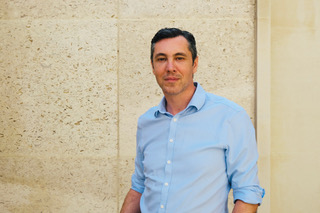Posted:
20 Sep 2021
During the summer an important audit is carried out which includes checking on one of the few objects that link directly to Trinity Hall’s founding in 1350.
The annual Silver audit is undertaken under the watchful eye of the College Butler, Sara Rhodes; Staff Fellow in Pathology, Dr Anton Enright; and Staff Fellow in Modern and Medieval Languages, Dr Leila Mukhida.
It was Anton’s first year undertaking the audit and he was delighted to learn more about the collection and one striking piece in particular: the Founder’s Cup. He not only discovered how beautiful it is, but also the historic links it has with our founder, Bishop Bateman. The scientist also discovered that the history of the cup was revealed by a predecessor of his, and former College Master, who wrote a detailed analysis of the cup in the 1930s.
Anton said: “Sara knows the collection extremely well and it was a real pleasure to spend the morning under her guidance counting spoons, identifying silver frogs and all manner of strange silver bequests to the College.
“I knew a little about the Founder’s cup. But I’ve only ever seen black and white photos of it. It’s a really unique and rare piece of silverware. It’s hallmarked which wasn’t common for silver for many years later.”
Anton noted that the last historical investigation he could find of the Founder’s Cup was done by a former head of his Department (Pathology) in the 1930s: “Henry Roy Dean – known as Daddy Dean – was both Master at Trinity Hall and the Professor of Pathology. So, if you want a real fish out of water it’s how Professor Dean an eminent medic, scientist and Cambridge personality was publishing articles on the provenance of the College silverware in 1935.”
In an article Anton discovered from 1935’s The Burlington Magazine for Connoisseurs Professor Dean and his co-authors note that: “The Trinity Hall Founder’s Cup, the oldest of the silver cups in the possession of the Cambridge Colleges, is well known as one of the most important examples of the fourteenth-century goldsmiths’ work.

Dr Anton Enright
“The tradition preserved in the College that the cup is the gift of the Founder, William Bateman, Bishop of Norwich, has not been seriously questioned, but the place where the cup was made has never been established and, as far as we know, the hall-mark has never been identified.”
The article describes how, through detective work focussing on the hallmark on the cup, the link between Bishop Batemen and the cup was discovered to be very strong indeed.
Trinity Hall was founded in 1350 and Bishop Bateman died in Avignon, while visiting the Papal Court there, on 6 January, I355.
The arms of the then Pope, Innocent VI, correspond strikingly to the arms on the Founder’s Cup. The article concludes:
“It seems reasonably certain that the mark is the mark of the assay office of the papal court of Innocent VI and that the cup was made and marked at Avignon between 1352, the year of the accession of Innocent VI, and January 1355, the date of the death of Bishop Bateman. Moreover, the association of the arms of the hall-mark with the papal court at Avignon, to which place Bateman made several visits, establishes beyond any reasonable doubt the College tradition that the cup was given to Trinity Hall by the founder.”
Aside from the fascinating history, Anton says the Cup’s enduring fascination is its beauty: “I think the fact remains that it’s a fascinating and beautiful object and it looks tremendous in colour, something I wasn’t expecting. I’ve only ever seen black and white photos and hadn’t realised there was colourful enamel work on the bottom.”
I think the fact remains that it’s a fascinating and beautiful object and it looks tremendous in colour, something I wasn’t expecting.
Excerpts are from the article: The Founder’s Cup at Trinity Hall Author(s): H. R. Dean, H. C. Gutteridge and C. C. Oman Source: The Burlington Magazine for Connoisseurs, Vol. 66, No. 387 (Jun., 1935), pp. 286-287
Main image: Founder’s Cup mark